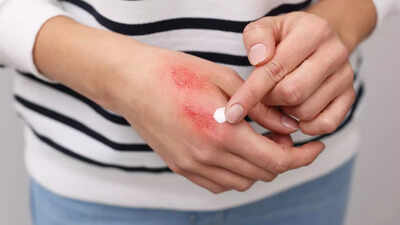ARTICLE AD BOX

Diwali celebrations often come with fun traditions, but some social media trends can be unexpectedly dangerous. This year, a viral “sanitiser handshake” challenge caused sparks when two people shook hands after applying alcohol-based hand sanitiser, resulting in painful burns.
These incidents may look entertaining online, but even brief contact with flames and alcohol can damage the skin, causing redness, blisters, and potential long-term scarring. Understanding how to care for a burnt hand is crucial for fast healing, reducing discomfort, and preventing infection. Knowing proper first aid, including cooling the burn, gentle cleaning, and applying soothing ointments, can make a significant difference in recovery and help avoid serious complications during festive celebrations.
Viral sanitiser handshake trend: Risks and dangers of hand burns
The trend went viral as a short stunt where two people applied hand sanitiserand shook hands, igniting a brief flame. Although the video gained attention on social media, healthcare experts warn that alcohol and fire burns are serious. Even brief contact can damage the skin, and severity varies with skin sensitivity and the amount of alcohol used. A study published in the Indian Journal Burns reported three cases of accidental flame burns occurring due to improper use of alcohol-based hand sanitizers.
All burns were major and required inpatient treatment, with one case necessitating a fasciotomy for compartment syndrome. The study emphasizes that burns arising from the combustion of alcohol-based sanitizers are increasingly reported, highlighting the risks associated with their improper use.
Common symptoms include immediate pain, redness, and blister formation within hours. Deeper burns may require medical attention, while broken skin increases infection risk. Understanding the dangers highlights the impor
How to treat minor hand burns
Proper first aid for minor burns can reduce pain, prevent infection, and promote faster healing. Key steps include:
- Cool the burn immediately: Place the affected hand under running cold water for 10–20 minutes. Avoid direct ice, which can worsen tissue damage.
- Clean gently: Use mild soap and water to remove debris. Avoid scrubbing to prevent further injury.
- Do not pop blisters: Blisters act as a natural protective layer. Breaking them increases infection risk.
- Apply soothing ointments: Aloe vera gel or doctor-recommended burn creams can reduce inflammation and support skin regeneration.
- Cover lightly: Protect the burn with sterile gauze to prevent friction or contamination.
- Pain management: Over-the-counter pain relievers, such as paracetamol or ibuprofen, can help reduce discomfort.
Additional tips include keeping the hand elevated to reduce swelling, staying hydrated, and monitoring for infection signs such as pus, spreading redness, or fever.
Avoid home remedies like butter or toothpaste, which can worsen tissue damage.
Festival burn prevention tips: Stay safe while celebrating Diwali
Preventing burns is always better than treating them. Simple precautions can reduce risk during festive celebrations:
- Avoid using alcohol-based products near open flames or fireworks.
- Keep a bucket of water or a fire extinguisher nearby when handling crackers.
- Educate children and friends about safe celebration practices
- Refrain from imitating dangerous social media trends, even for short videos.
Being cautious ensures that festive fun does not lead to painful injuries or hospital visits. Awareness of safety measures can help everyone enjoy Diwali responsibly. The sanitiserhandshake trend shows how combining fire with alcohol-based products can cause serious hand burns.
Quick and proper first aid, cooling, cleaning, applying soothing ointments, and monitoring for infection, can reduce pain, prevent complications, and speed recovery.
Following preventive measures and celebrating safely allows you to enjoy Diwali without unnecessary injuries. Understanding these risks encourages safer choices, helping families and friends celebrate the festival joyfully and responsibly.Disclaimer: This article is for general informational purposes only and is not a substitute for professional medical advice, diagnosis, or treatment. Always seek the guidance of a qualified healthcare provider regarding any medical condition or lifestyle change.Also Read: Mary River turtle: The fascinating reptile that breathes through its bum

 4 hours ago
6
4 hours ago
6









 English (US) ·
English (US) ·